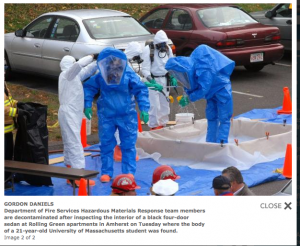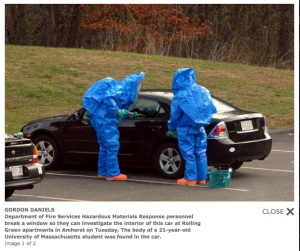A Umass Amherst student was found dead, an apparent poisoning, at an Amherst apartment complex.
Hydrogen sulfide is the rotten egg smell of sewer gas, and suicides by voluntarily inhaling the gas are virtually non-existent. This did not prevent the authorities, after an extensive 3 hour investigation, to conclude that the student decided to commit suicide by inhaling the chemical in a black sedan that did not belong to him.
N0vember 9, 2010 – UMass Student death – chemical release
Related story (2013 Feb. 19) – Another Suspicious UMass Hydrogen Sulfide suicide
AMHERST – Police are investigating the unattended death of a 21-year-old University of Massachusetts student and a deadly chemical release inside a parked car at the Rolling Green apartments off Route 9.
 Police and fire officials, including personnel from the Department of Fire Services Hazardous Materials Response unit, evacuated the parking lot at the 422 Belchertown Road complex Tuesday morning to take a closer look at a suspicious vehicle, where the man’s body was found. Police were called to the scene at 9:04 a.m. after a passer-by made observations about the vehicle, said Detective Lt. Ronald A. Young, head of the Amherst Police Detective Bureau.
Police and fire officials, including personnel from the Department of Fire Services Hazardous Materials Response unit, evacuated the parking lot at the 422 Belchertown Road complex Tuesday morning to take a closer look at a suspicious vehicle, where the man’s body was found. Police were called to the scene at 9:04 a.m. after a passer-by made observations about the vehicle, said Detective Lt. Ronald A. Young, head of the Amherst Police Detective Bureau.
Young said a “chemical exposure was evident” at the scene of the death. Fire Chief Tim Nelson – who called for the hazardous materials team – said the chemical found was hydrogen sulfide.
The victim is not being identified until his next of kin are notified, Young said.
Police contacted the man’s roommates and interviewed them and others who live at the complex, Young said.
Young would not speculate on the cause of death.
He said that the body did not appear to have been in the vehicle, a black four-door sedan, for more than a day. Police were waiting for more information from the state medical examiner and the district attorney’s subsequent investigation.
“We are exploring all the options,” said Young. “As you know, the investigation is in its infancy.”
Generally, when hydrogen sulfide is found on the site of a death, Nelson said, it’s suicide. It’s also a toxic and flammable substance, Nelson said, noting that the chemical can be a byproduct of household chemicals and can also be found in below-grade sewer lines.
Nelson said when he was notified by police about the suspicious scene, he called for a Tier 2 response. That brought about two-thirds of the regional hazardous materials team to the scene. Its members began metering around the car “to check if the gas is still being generated, (and) make sure the scene is safe,” Nelson said.
In many reported cases of such suicides, a note is left warning people not to open the doors to the vehicle because of the dangerous chemical inside. Police did not say if a note was left on the scene.
Resident Bob Martinelli, who has lived at Rolling Green for 15 years, resides in an apartment next door to a unit that was searched by the authorities. He overheard hazmat responders talking about the body while he and others were temporarily evacuated from their building around 9:30 a.m.
Martinelli said he noticed a chemical scent in the area around his unit, describing it as something he hadn’t smelled before.
“You just knew something was wrong. It’s a smell you never smell,” said Martinelli. Police said any chemical smell in the buildings likely emanated from the car.
Jehan El-Bisi, another resident, said in an interview with television reporters that she noticed the smell two nights ago.
The evacuation only lasted a brief time, as residents were allowed to go back into their building in less than an hour.
But resident Joan Logan was upset her car was quarantined inside the sealed-off lot. Officials also turned cars away from Lot J, which fronts the main road, and used that parking lot as a staging area for hazmat workers.
A large number of emergency workers, dressed in blue and gray chemical-proof suits, were working at the scene from morning to early afternoon.
At 12:15 p.m., two of the responders entered the sedan, breaking the window to get inside, opened all the doors and the trunk, and measured the air with an electronic device.
A white pail was removed from the vehicle and placed in a large yellow HazMat container.
Meanwhile, two other blue-suited HazMat responders, who had moved away from the car, were washed off in a decontamination station.
Nelson, who brought expertise in hazardous materials when he became fire chief earlier this year, said he was pleased with the cooperative approach.
“The team did a great job, my guys did a great job,” Nelson said.
Tuesday morning the Amherst Police Department responded to Rolling Green Apartments on Route 9 at approximately 9:04 a.m. and found the body of 21-year-old University of Massachusetts student Jason Miner in a four-door black Ford Fusion sedan parked in the complex’s lot.
Residents of the complex smelled a strange odor coming from the vehicle before summoning authorities. Officers that arrived on the scene investigated the contents of the automobile, and became “aware that potentially hazardous materials were present in the car.”
Officials found hydrogen sulfide at the scene – an extremely toxic chemical that can be created with household products and is commonly used for suicide.
After transferring to UMass this semester, Miner was on pace to graduate in 2013 with degrees in psychology and physics, according to UMass spokesman Edward F. Blaguszewski.
Emergency personnel proceeded to evacuate portions of Rolling Green after the discovery. The Department of Fire Service Hazardous Material Response and the Amherst Police and Fire Departments were on the scene until around 2:30 p.m. After the initial evacuation, residents or visitors to Rolling Green, located at 422 Belchertown Rd., were allowed to use the entrances or exits of the complex while officials were on the scene. However, some cars and parking lots were quarantined while investigators worked, frustrating some residents.
Samuel Sweeney, a junior communications major at UMass and resident of Rolling Green, was at home at the time of the incident, in an apartment located just a few doors down from where the body was discovered.
“I got a call from one of my friends saying that he heard people in Rolling Green were being evacuated,” said Sweeney during an interview with the Massachusetts Daily Collegian. “I didn’t even know, because I was inside working on a paper. Then I looked outside my window, and it was chaos.”
According to Sweeney, from his vantage point he could see a multitude of “fire trucks, ambulances, police, and a lot of other emergency vehicles.”
“We were allowed to leave by bus – but if your car was parked in certain lots, like mine was, you couldn’t get to it,” said Sweeney of the quarantined areas. “I wasn’t able to leave for hours.”
Investigators do not believe that this death is suspicious of foul play, according to an initial Amherst Police press release.
Hydrogen sulfide is made by combining toilet bowl cleaning products and a common insecticide to create a lethal gas that tends to sit at the bottom of poorly-ventilated areas. It first became common in Japan, where, in 2008, over 500 individuals used it to commit suicide. The gas also carries a significant risk to bystanders, as occurred in April 2008 when the hydrogen sulfide suicide of a 14-year-old Japanese girl sickened another 90 people living in her apartment building, according to FOX News.
According to the APD release, a joint investigation is continuing between the Northwestern District Attorney’s office and the Office of the Chief Medical Examiner.
– Collegian News Staff




